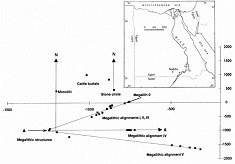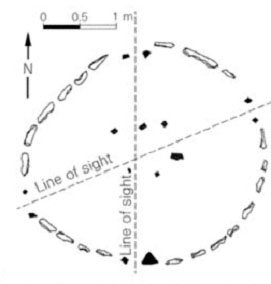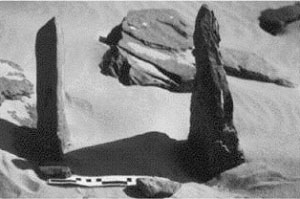
 |
| Photo © Nature Publishing Group |
Background:
Nabta Playa is a natural depression with an area of about 5000 square kilometers (2000 square miles) located west of the Nile River in what is today southern Egypt. Until roughly 11,000 years ago, the wide plains of Nabta Playa were too dry to support permanent human settlement. But by then, weather patterns began to shift and scientists think that summer monsoons of Central Africa began to reach into the area, creating large temporary lakes or playas.
 |
| Click on the map to see a larger view Photo © Nature Publishing Group |
Scientists have hypothesized that over time these lakes encouraged increasingly complex human societies to form. Evidence points to early transhuman cattle pastoralism (meaning humans migrated with their animals every year), as well as the elaboration of religious beliefs and cultural practices. But beginning about 9000 years ago, larger permanent settlements developed that relied on wells in addition to sheep, cattle, and goat herding. After a period of intense drought between 8000 and 7000 years ago, the climate again shifted to support permanent settlement in the playa, and scientists believe these groups developed a sophisticated society centered on religious beliefs. Most importantly, it appears that by about 6500 years ago, inhabitants at Nabta Playa developed a sophisticated, accurate way of marking time and seasons, using the stars as their guides. About 4800 years ago, another climate change occurred, and today scientists believe that the Nabta inhabitants may have gradually made their way into the more fertile Nile River Valley—but no one knows for sure. Are these people the ancestors of ancient Egypt? Maybe, but much more research is required.
 |
| Image © Nature Publishing Group |
Astronomical significance:
Nabta Playa is currently the oldest known archaeoastronomy site in the world, older than Stonehenge by at least 1000 years. There are five known alignments of megaliths stretching out from a group of central megalithic structures at the settlement. When archaeoastronomers began to draw lines along the alignments, they realized that the lines very closely matched the direction of sunrise on the summer solstice, as well as the rising points of Sirius, Dubhe, and Orion's Belt. In addition, vertical stones—which would cast no shadow when the Sun passes directly overhead—marked the sun's zenith passage, which happens each year about three weeks before and three weeks after the solstice, and may have signaled the onset of the summer monsoons. Scientists also found several strong north-south and east-west alignments that might have helped Nabtians navigate and track stellar movements.
 |
| Photo © Nature Publishing Group |
Why are megaliths important to us today? Well, building a megalith isn’t easy. And building a megalith that actually accurately measures the movement of stars across seasons is even harder. Think of it: first you have to know a lot of people to help you move some very large rocks. Each megalith at Nabta Playa is about 2 m (6 feet) wide by 3 m (9 feet) high. Then you have to convince your friends that moving a large slab is worthwhile. The megaliths at Nabta Playa probably came from a quarry at least 0.5 km (0.3 mile) away from where Nabtians finally placed them. That's quite an effort. And then you have to carefully watch the sky and track stars as they move across the sky over the years, so that the megaliths can be properly aligned. Finally, the Nabta megalith slabs are actually carved, which might have shown certain stellar alignments based on the shape of the stone. So the complexities of building a megalith can tell us quite a bit about the society that built it.
 |
| Photo © Nature Publishing Group |
Because building the megaliths at Nabta Playa took significant organization and skills, scientists think that the Nabtians had, by about 6500 years ago, developed a fairly advanced society. They could organize labor to move the slabs, build a number of houses, dig wells, and perhaps even specialize in certain kinds of tasks, sharing the burdens of everyday life. The sophistication and accuracy of the megaliths themselves, along with evidence of cattle worship that anthropologists and archaeologists recently discovered, also tell us that this society probably developed in complexity over time.
References:
Holocene Settlement of the Egyptian Sahara: The Archaeology of Nabta Playa, Fred Wendorf, Romuald Schild, Kit Nelson, eds., Kluwer Academic/Plenum Publishers, New York, 2001.
Malville, J. McKim, et al., "Megaliths and Neolithic Astronomy in Southern Egypt," Nature, April 2, 1998.
Useful links:
Minnesota
State University emuseum
NASA Ancient Observatories
Southern
Methodist University Anthropology Department
University
of Colorado at Boulder